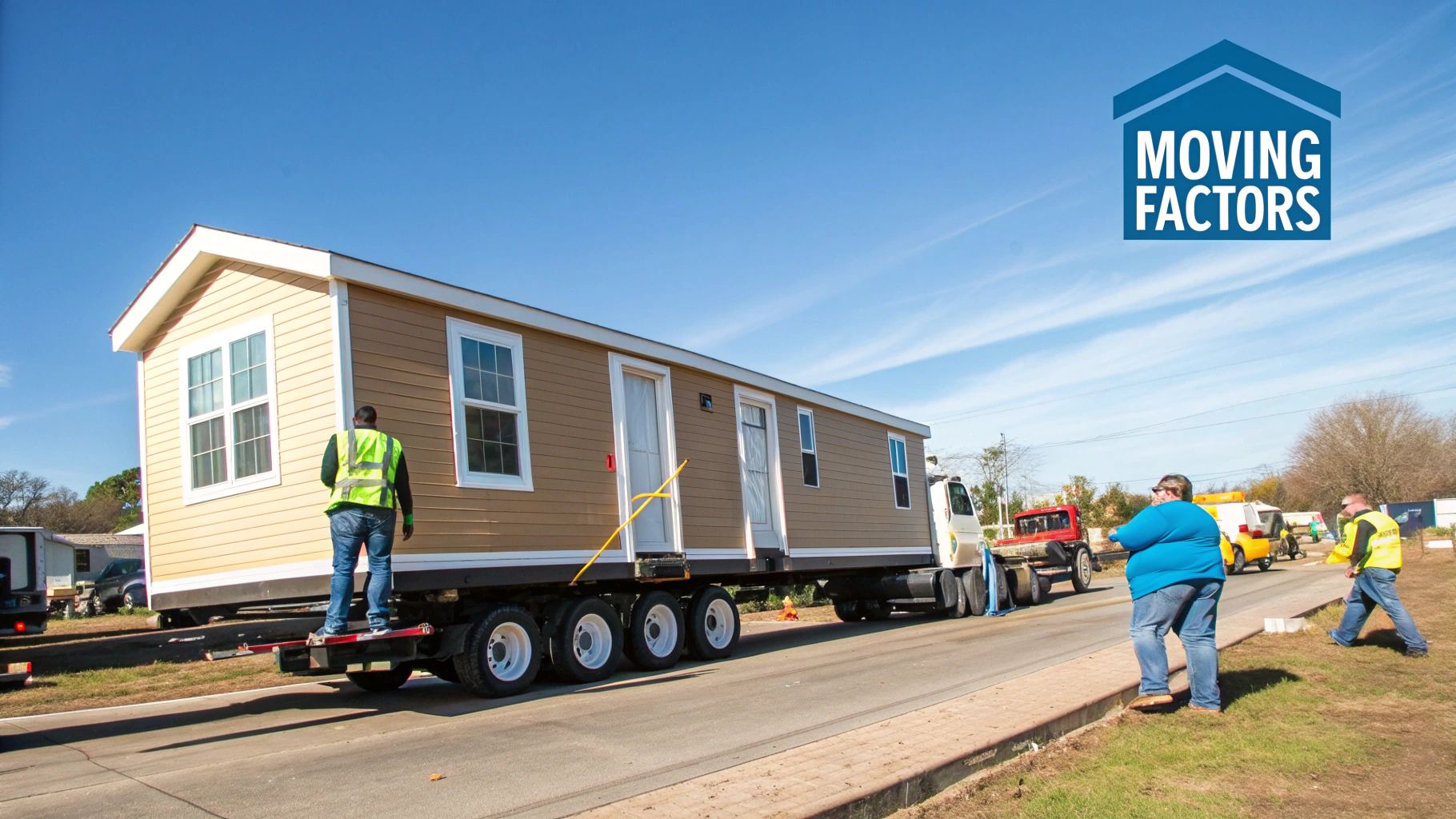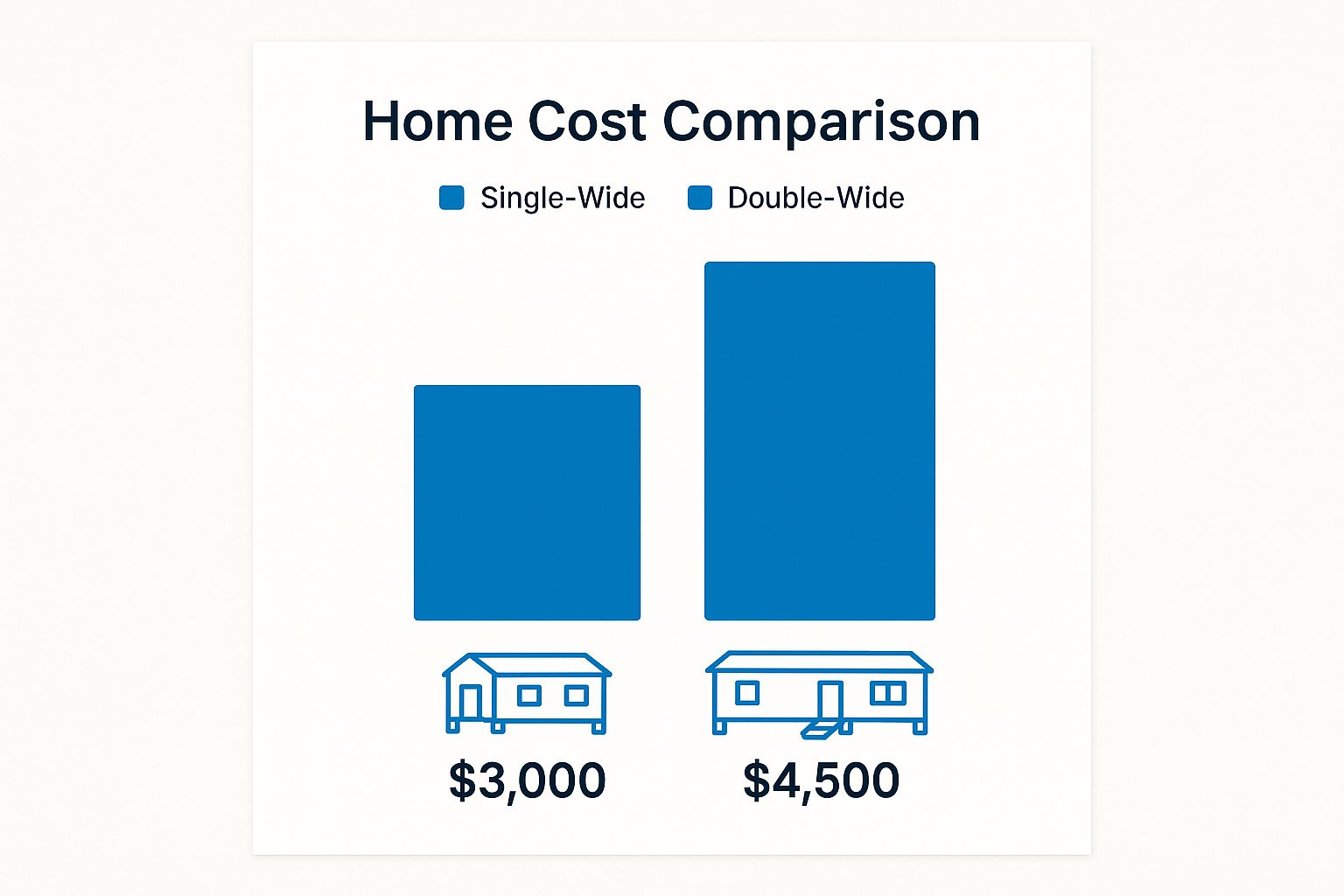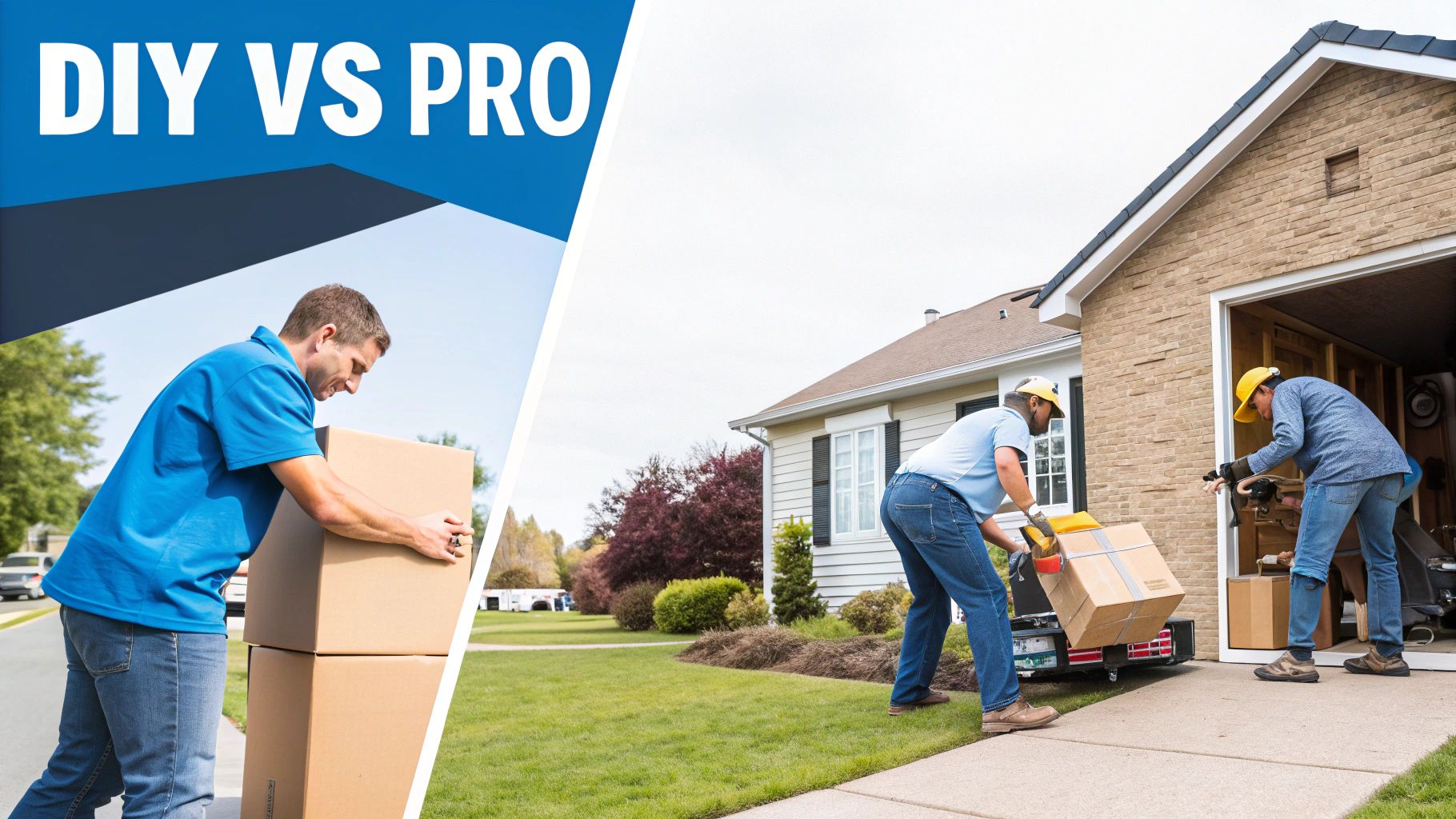
Moving a mobile home is a significant undertaking, and the first question is always about the bottom line: "What is this actually going to cost?"
On average, you can expect the cost to move a mobile home to fall between $5,000 and $13,000, with most homeowners landing around the $8,500 mark. This range is a solid starting point, but your final invoice will depend entirely on the specifics of your move—namely, your home's size, the travel distance, and the level of service you require.
Your Quick Answer on Mobile Home Moving Costs

Let's dive into that financial snapshot. The typical $5,000 to $13,000 price range, with an $8,500 average, reflects current market conditions, accounting for factors like fuel costs, labor, and state-by-state permit requirements. For a deeper dive into how these factors come together, check out the breakdown on vanlinesmove.com.
Think of this estimate as the base fare. The final cost depends on the services you add. The two biggest variables that will shape your quote are the size of your home and the distance it needs to travel.
Estimated Mobile Home Moving Costs at a Glance
This table provides a practical estimate based on home size and move distance, helping you budget for the core transport expense.
| Home Size | Short Distance Move (<50 miles) | Long Distance Move (>50 miles) |
|---|---|---|
| Single-Wide | $5,000 – $8,000 | $8,000 – $11,000 |
| Double-Wide | $8,000 – $11,000 | $11,000 – $13,000+ |
As you can see, a larger home or a longer journey significantly increases the cost. However, the most critical decision you'll make is choosing the type of service you need.
Understanding Your Service Options
The service package you select is a primary driver of your total cost. You have two main choices: a basic transport-only service or a comprehensive full-service move. Each offers a different level of convenience and cost.
Transport-Only Move: This is the most basic and budget-friendly option. The moving company is responsible only for hitching your home, transporting it to the new location, and unhitching it. You are responsible for all preparation (disconnecting utilities, removing skirting) and all setup (reconnecting utilities, re-installing skirting).
Full-Service Move: This is the all-inclusive, hands-off package. The moving company manages every logistical detail: disconnecting utilities, removing skirting and attachments, transporting the home, placing it on the new foundation, and reconnecting everything to make it move-in ready.
A full-service move provides complete peace of mind, ensuring every technical detail is handled by professionals. A transport-only move can yield significant savings if you have the skills, tools, and time to manage the site work yourself.
Deciding between these two options is the first step in building an accurate budget. As we explore the details, you'll see how your home's dimensions, the transport route, and other essential services contribute to the final price.
Cracking the Code on Your Mobile Home Moving Quote
A moving quote is a detailed breakdown of the logistical challenges of your specific move. Understanding its components empowers you to compare offers accurately and avoid surprise costs. The final price is a calculation based on your home's specifications and the route it must travel.
Think of it like planning a complex freight shipment. The cost isn't just mileage; it's the size of the cargo, the difficulty of the route, and the specialized equipment required.
The Big Three Cost Drivers
Every quote is built on three core factors. These elements have the most significant impact on your budget and explain the price variations between seemingly similar moves.
- Home Size and Weight: This is the single most important factor. A double-wide isn't just bigger; it's two separate oversized loads that must be professionally separated and perfectly rejoined. This requires two transport trucks, double the permits, and a larger, more skilled labor force for both disassembly and reassembly.
- Travel Distance: The mileage from point A to point B directly impacts fuel costs, driver hours, and equipment wear. Most movers use a per-mile rate, typically ranging from $4 to over $15 per mile, depending on the complexity of the transport. Long-distance moves may also include costs for the crew's overnight accommodations.
- Home Age and Condition: An older home, especially one built before the 1976 HUD code, often requires more careful handling. The mover may need to reinforce the frame or bring their own transport axles and tires if the home's are not roadworthy. This specialized attention and equipment adds time, labor, and insurance costs to the job.
Route and Location Challenges
The journey itself is a major cost component. A straight, flat interstate route is far less expensive than one with logistical hurdles.
A challenging route with narrow roads, tight turns, or low-hanging obstacles requires more than just a driver—it demands a skilled logistical team, pilot cars, and meticulous planning, all of which are reflected in your final quote.
Movers must account for any obstacle that adds time, risk, or complexity. Winding rural roads, congested city streets, or steep mountain passes often require pilot cars (escort vehicles) to ensure safety. This service alone can add $1.50 to $1.65 per mile for each required escort car.
Other potential route costs include temporarily lifting power lines, coordinating with local authorities to manage traffic, and re-routing to avoid low bridges, which adds miles to the trip. Partnering with experienced mobile home movers is the best way to anticipate these challenges and get an accurate, all-inclusive quote.
Transport Only vs. Full-Service Moving
Choosing your service type is a critical decision that directly influences your final cost and personal workload. The two primary options—"Transport-Only" and "Full-Service"—cater to different budgets and needs.
Let's break down what each service entails so you can make an informed choice.
What’s Included in Each Service?
A Transport-Only move is exactly what it sounds like: the moving company's responsibility is limited to hauling the home from point A to point B. This is a hands-on option where you manage all the prep and post-move work. This includes disconnecting utilities, removing skirting, and taking down any attached structures like decks or porches.
A Full-Service move is the comprehensive, turn-key solution. The moving crew handles the entire process, from disassembly at the old site to complete re-installation at the new one. This includes leveling the home, re-connecting utilities, and ensuring it's ready for occupancy. It's a hands-off approach that minimizes your stress and workload.
To get a clearer picture, let's compare them side-by-side.
Comparing Transport-Only and Full-Service Moves
The table below outlines the key differences in services, your responsibilities, and the typical costs associated with each option.
| Feature | Transport-Only Move | Full-Service Move |
|---|---|---|
| Services Included | Hook-up and transportation of the home to the new site. | Disconnection, transport, re-installation, leveling, and utility reconnection. |
| Your Responsibility | All prep and post-move work: utility disconnections, skirting removal, tie-downs. | Minimal; you focus on personal belongings and paperwork. The movers handle the technicals. |
| Average Cost Range | $1,000 – $3,500 | $5,000 – $15,000+ |
The cost difference primarily comes down to labor. A transport-only move offers significant savings, but only if you have the necessary skills, tools, and time to prepare the home for transport and set it up afterward.
The infographic below illustrates the baseline transport cost, which forms the core of any moving quote.

This visual clarifies why double-wide transport is inherently more expensive—it is effectively two separate, coordinated moves.
Which Option Is Right for You?
The best choice depends on your budget, skills, and timeline. If you have experience with home projects and are aiming for the lowest possible cost, a transport-only move is a viable option.
However, for anyone who values convenience and wants the assurance that every technical detail is handled by professionals, a full-service move provides invaluable peace of mind.
Be realistic about your capabilities. Errors during disconnection or setup can lead to expensive damage. Often, hiring experts for a full-service move is the most cost-effective choice in the long run.
To understand the precise cost for your situation, the most effective action is to get a free shipping quote and compare the detailed proposals for both service types.
Unpacking the True Cost of Your Move

The transport quote is the centerpiece of your moving budget, but it's not the final number. A successful move involves several additional costs that are crucial for creating a realistic financial plan. These are not "hidden" fees but standard expenses associated with relocating a manufactured home.
From regulatory paperwork to site preparation, each stage has its own price tag.
Getting Ready: Pre-Move Prep and Permits
Before the move begins, you must account for several upfront costs required to make the transport legal and safe.
Transport Permits: Every state and county on your route will require specialized oversized load permits. These fees can range from $100 to over $500, depending on the jurisdictions your home will pass through.
Pilot Cars: As a designated "oversized load," your home will legally require professional escort vehicles. These cars ensure road safety and typically cost $1.50 to $1.65 per mile each. You can learn more about the logistics of hauling oversize loads.
Inspection Fees: The mover or local authorities may require a structural inspection, especially for older homes, to certify it is safe for transport. This is another necessary pre-move expense.
Settling In: Post-Move Setup and Site Work
The transport fee covers getting your home to the new property, but not making it habitable. Preparing the new lot and installing the home are separate and significant expenses.
The moving company delivers the structure; you are responsible for turning it into a home.
The journey to the new site is only half the battle. Preparing the land, setting the foundation, and connecting utilities are substantial costs that must be factored into your total moving budget from day one.
After the transport truck leaves, you will need to budget for everything required to obtain an occupancy permit. This is essential for legally living in your home. Be prepared for costs such as:
- Lot Preparation: This can range from simple ground leveling to extensive tree clearing, grading, and drainage work.
- Foundation: A new foundation must be installed, whether it's a concrete slab, piers, or another approved system.
- Utility Reconnection: Licensed plumbers and electricians are required to connect your water, sewer, and electrical systems safely and to code.
- Skirting and Decks: Re-installing skirting and rebuilding stairs, decks, or porches are the final steps that add to the total cost.
How Home Size Impacts Your Final Bill
The size of your mobile home is the single biggest factor determining your moving costs. The logistical difference between moving a single-wide and a double-wide is immense, and the price reflects that complexity.
Moving a single-wide home is a large, specialized transport job. It is one unit moving from one location to another.
Moving a double-wide home is a far more complex operation. It is effectively two separate, coordinated moves that must be executed with precision.
The Double-Wide Dilemma
The significant price increase for a double-wide is due to the process of splitting the home into two halves for transport. This is a skilled deconstruction process that occurs along the home's "marriage line."
Once separated, the costs multiply:
- Two Trucks, Two Drivers: You are hiring two transport rigs, which means double the fuel, driver pay, and equipment rental for the same distance.
- Double the Paperwork: Each half is legally its own oversized load, requiring two separate sets of transport permits for every jurisdiction on the route.
- More Boots on the Ground: The job requires a larger crew with expertise in both separating and rejoining the home seamlessly.
- The Big Reassembly: "Stitching" the two halves back together is a meticulous process. It must be perfectly aligned, sealed, and made structurally sound. This is labor-intensive work that demands expertise.
This logistical complexity is why a full-service move for a single-wide often costs $5,000 to over $10,000, while a double-wide ranges from $10,000 to $18,000 or more. For more detail on these figures, you can find in-depth cost breakdowns at banyanmobilehomeremoval.org.
Essentially, moving a double-wide isn't just one big job—it's two big jobs that have to be flawlessly executed as one.
Understanding this from the start helps you set a realistic budget. The higher quote for a double-wide directly reflects the doubling of labor, equipment, and administrative work required to move your home safely.
Actionable Tips to Lower Your Moving Expenses

While moving a mobile home is expensive, strategic planning can significantly reduce the final cost without compromising safety. A proactive approach can turn a daunting expense into a manageable one.
The single most effective action you can take is to get at least three detailed, itemized quotes from reputable mobile home movers. Comparing bids not only helps you find the best market rate but also provides leverage for negotiation. Ensure each quote lists the same services so you are comparing apples to apples.
Strategic Planning for Maximum Savings
Your timing can have a direct impact on your moving costs. The transport industry has peak and off-peak seasons.
Move During the Off-Season: Demand for movers is highest in the summer. Scheduling your move for the fall, winter, or early spring can result in more competitive pricing as companies look to fill their schedules.
Be Flexible with Dates: If you can offer a flexible moving window instead of a fixed date, the company may be able to fit you into their schedule more efficiently, sometimes passing those savings on to you as a discount.
Don't underestimate the power of your own labor. Taking on some of the prep work yourself is one of the most direct ways to lower the quote for a full-service move.
Do-It-Yourself Prep Work
If you are comfortable with DIY projects, handling some of the preparation can directly reduce the labor costs on your quote.
Consider taking on these tasks:
Removing Skirting and Decks: Carefully disassemble and pack your home's skirting, steps, and any attached porches.
Disconnecting Utilities: If you have the expertise, disconnecting water and power can save money. However, for gas lines, always hire a licensed professional. Safety is paramount.
Interior Preparation: Secure the interior of your home. Latch cabinets, lock windows, and brace doors to prevent them from swinging open and causing damage during transport.
By completing these tasks, you reduce the mover's workload, which should be reflected in a lower price. Another practical tip: if you have a shed or carport you don't need at the new location, sell it instead of paying to move it. This cuts costs and adds cash to your budget.
Got Questions About Moving Your Mobile Home? We've Got Answers.
Planning a mobile home move involves many questions. Here are clear, practical answers to some of the most common concerns we hear from homeowners.
Can You Move an Older Mobile Home?
Yes, but with important considerations. Homes built before the 1976 HUD code require special attention, as their construction standards were different and the frame may be less robust.
A reputable mover will require a thorough structural inspection to ensure the home's chassis can withstand the stresses of transport. Be prepared for higher insurance costs and budget for potential repairs that may be needed after the home is set at its new location.
Do I Really Need to Be There for the Move?
While you don't need to be present for the entire journey, it is highly advisable to be on-site during two critical phases: the disconnection/loading and the delivery/setup. Your presence allows you to act as the project manager.
Being on-site lets you answer questions, make immediate decisions, and inspect for any potential damage as it happens, which can prevent disputes and complications later.
Being present at both the pickup and delivery spots is the single best way to keep everyone accountable. It lets you tackle any issues as they happen, which can save you a world of headaches later.
How Long Does a Mobile Home Move Actually Take?
The timeline depends heavily on the home's size and the travel distance. A local, single-wide move can often be completed in 1 to 3 days, from prep to final placement.
However, a long-distance, double-wide move is a much longer process. It involves time for splitting the home, slower travel speeds due to oversized load regulations, and then the detailed reassembly and utility hookups. A complex move like this can easily take a week or more from start to finish.
Planning a move takes know-how and the right equipment. The team at We Will Transport It has spent years managing complicated mobile home moves, making sure each home gets to its new location safely and without delays. To get a detailed quote and solid advice for your specific move, check out their website at wewilltransportit.com.





